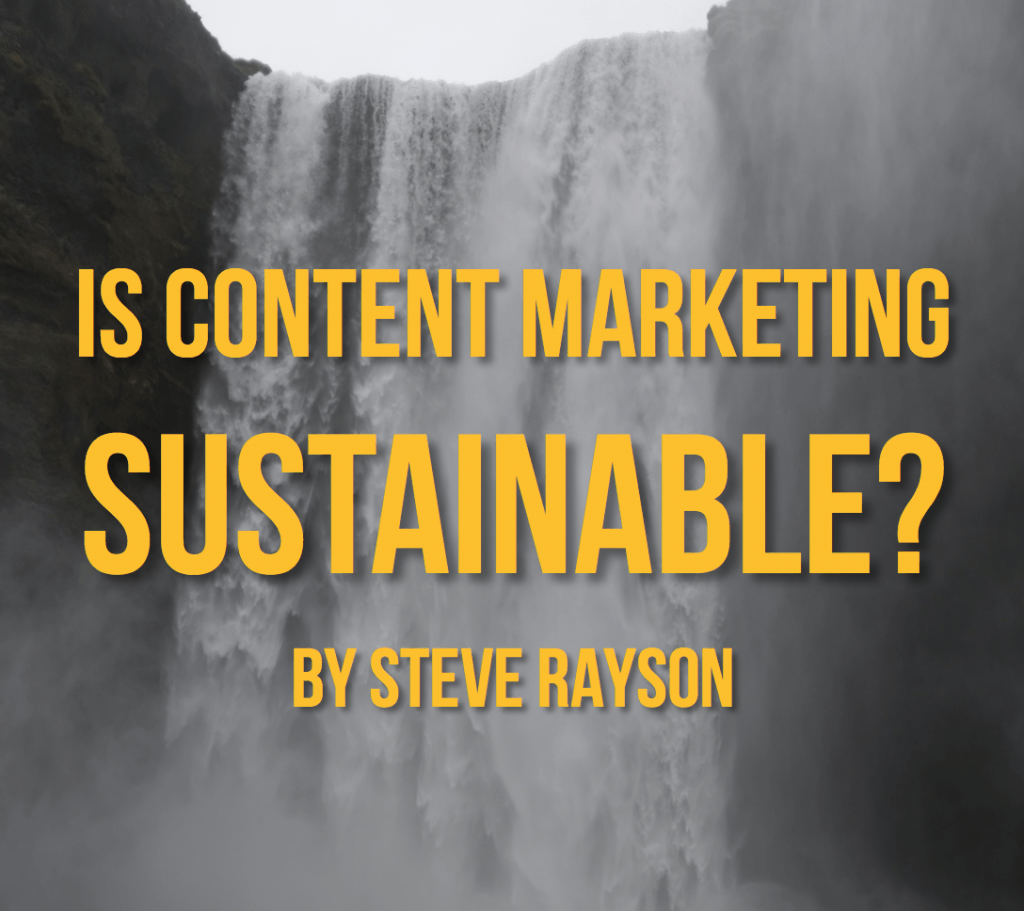
By Steve Rayson, Director, BuzzSumo
Is content marketing sustainable?
This is the question Mark Schaefer posed in his seminal “Content Shock” post in early 2014. Four years later, what does the data tell us about his predictions?
On the plus side it has never been easier to research and create content, from blog posts to videos.
However, as Mark predicted, lowering the barrier of content creation to near-zero has contributed to an exponential rise in content production, making it more difficult than ever to gain attention and engagement. This post takes an in-depth look at content trends, what Content Shock looks like today, and the implications for content marketers and content strategy.
Does Growth In Content Publication Mean Lower Returns?
Schaefer noted on this blog that the amount of content we consume on a daily basis had grown to nearly 11 hours per day (some estimate this is now up to 12 hours). However, he suggested there has to be a practical limit to the amount of content a person can consume and that if the content supply continued to explode it would impact the economics of content marketing. We’re creating a world where it will be increasingly hard for content to reach readers and where the rate of return on content marketing would fall.
I decided to look at recent trends in content publication and content sharing to see if this supported Mark’s hypothesis. What I found was a consistent pattern across many topic areas and industries.
In essence, as the volume of content published increases there is a fall in average engagement in terms of social sharing. For example, if we take a specific topic such as influencer marketing, we can see from the chart below that there has been a significant growth in articles about this topic over the last three years and that this has correlated with falling average shares of these articles on Twitter.
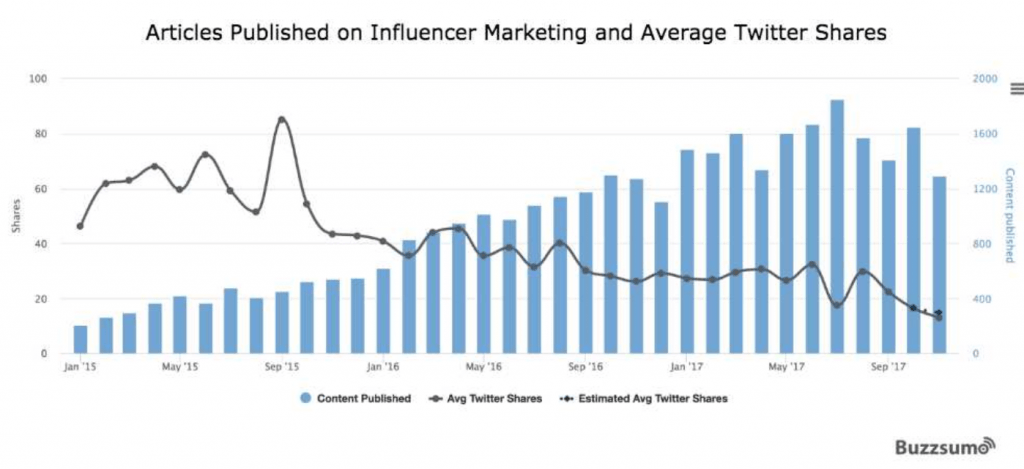
We find similar patterns across all social networks, though occasionally there are variations where average shares decline on one network but increase on another.
This decline in average engagement may be due to a number of reasons. For example, the volume of content may simply have saturated the market. Alternatively as more and more people jump on the bandwagon of influencer marketing the quality of the content may have declined, making people less likely to share articles. It’s probably a combination of factors. However, this chart is essentially exactly what Mark predicted would happen in a world of Content Shock.
Declining content engagement as publication volumes increase over time appears to be a common pattern.
We see this pattern when we look at the data for Content Marketing content and average shares across all networks below.
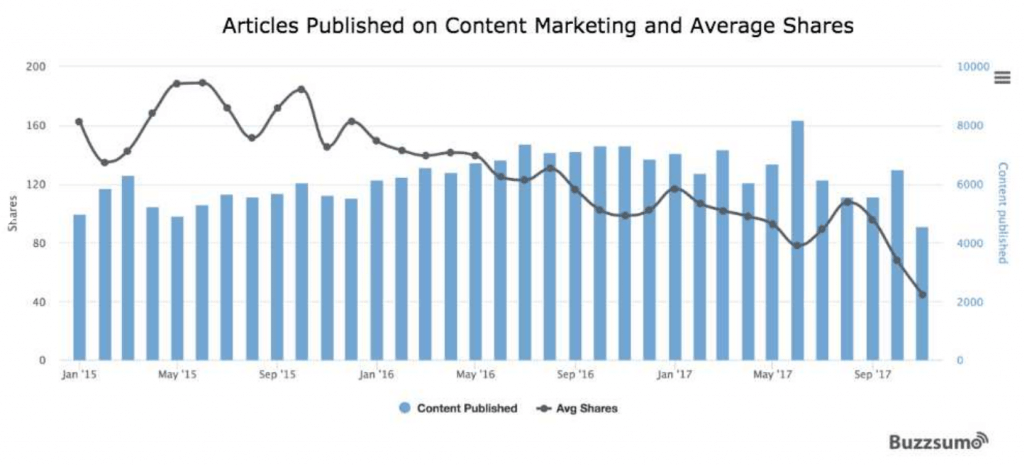
In this case, the number of articles about content marketing is relatively flat but it is still highly-saturated with more than 1,000 articles being published every week on the topic.
In some cases even where content volumes are falling we still see a decline in average shares. For example, the chart below shows that the number of articles about virtual reality peaked in 2016 but despite falls in content volumes average shares are still flat or declining. This is also likely due to content saturation with over 1,000 articles a week still being published on the topic.

The Pattern of Content Shock
The consistent pattern we see is growing interest in a topic that drives up both the number of articles and the total number of shares.
For example, below is the chart for machine learning articles showing shares across all networks (LinkedIn, Twitter, Facebook and Pinterest).

We see that the volume of content being published eventually exceeds the interest in the topic and this competition for attention leads to a decline in average shares. Interest in a topic also does not keep rising forever, it typically reaches a peak at which point we see total shares start to fall. Even when interest begins to wane at this saturation point, it is common to see that the number of articles continues to increase. It appears marketers climb on the content bandwagon past the point of effectiveness.
The decline in average shares may be due to a number of reasons, for example:
- People may not discover the posts as their feeds get inundated with content on a topic.
- There is not enough time for people to read and review content, possibly not enough time to even scan the headlines in areas where 1,000 articles are published each week on a topic (like content marketing).
- As marketers jump on a trend, poorer quality content is produced that people don’t wish to share.
- People might only share the top articles on a topic, so an increase in content doesn’t lead to an increase in sharing for latecomers.
In some established areas we see both content volumes and shares becoming stable, for example articles about the NFL, where volumes and average shares have remained fairly constant over recent years.
Content Shock Is Not Everywhere
The good news is that there are always topics which are earlier in the content cycle and where content saturation hasn’t happened yet, or where interest is still growing faster than content publication. For example, if we look at Bitcoin articles below, we can see average shares are increasing despite higher volumes of content.
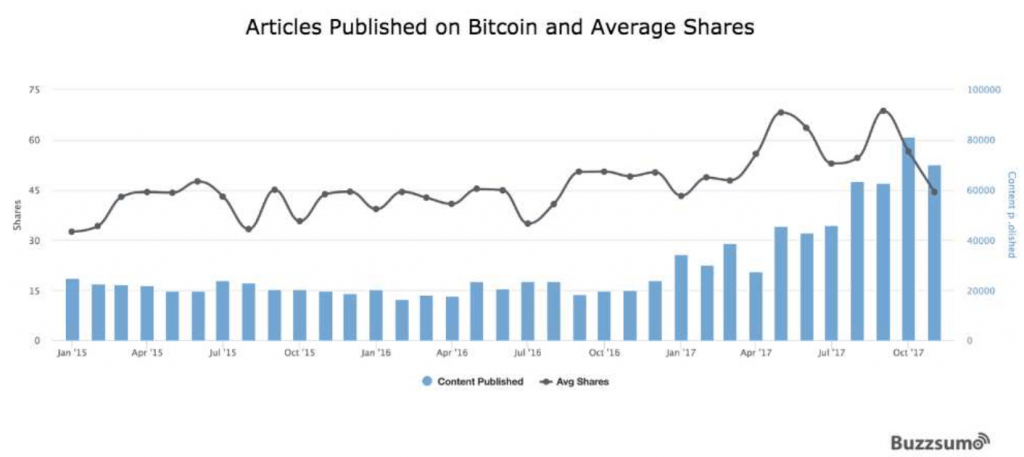
Politics is another area where we see growing engagement with content. For example, for articles published in The Guardian’s politics section below we can see quite a steep rise in average shares since last summer.
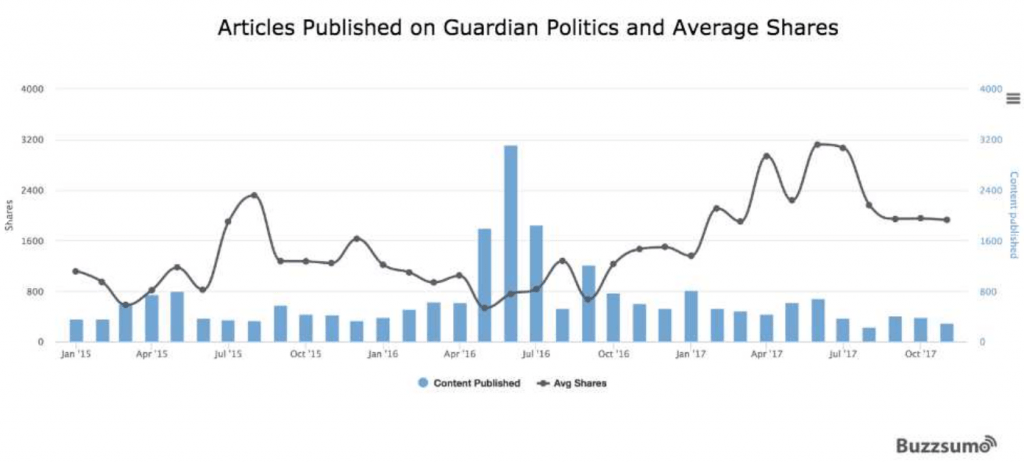
This is no surprise since the UK had a referendum on European Union membership last June and a General Election in 2017. There has also been heightened political awareness with the US Presidential Election and European elections in 2017. I personally think there is also more tribal sharing of political content where people share to show support for their tribe.
Thus despite living in a world of Content Shock there are always new and emerging topics of interest. A key challenge for content marketers is to identify and create content for these new areas of interest and to build an audience and authority before it becomes saturated with content.
If you only start creating content after the topic has become popular or after content saturation, it will be increasingly hard to gain attention and engagement. In fact, it might not work at all.
Is content marketing sustainable?
Mark forecast a world where organic reach would slump and where you would have to pay to promote your content to be visible (a radical new idea back then!). Mark posed the question of whether the cost of content promotion, combined with falling returns in attention and engagement, would become too high for some companies and whether the winners in a world of Content Shock would be the companies with the biggest pockets.
This is still a very relevant question. In saturated areas it is increasingly hard to gain attention and engagement organically — and even with paid promotion in some areas.
Is content marketing sustainable? The answer is, “it depends.” The right strategy depends upon the nature of the content market and your position in it. For example:
- If you are entering a saturated content market you need to look at creating radically different and exceptional content. Less is more when it comes to content production. Another “me too” list post will sink without trace. In our experience it is better to focus all of your promotion on a single day to become the story of the day rather than spread your promotion and amplification efforts over a period of time.
- In a saturated market you need to discover specific niches or networks where content is still gaining traction. We can see many examples where average shares are declining overall but rising on a specific network such as LinkedIn for content that is business focused.
- In a market experiencing Content Shock promotion and amplification is critical, including paid promotion. You may need to spend as much or more time on content promotion than on content creation.
- If you are already a leader in a saturated area producing more content may be a viable strategy to effectively create Content Shock for your competitors. In a more recent post Mark correctly wrote that Content Shock isn’t the problem, it’s the solution. By producing high quality, core evergreen content, and also regular content such as news, updates and practical tips, you provide less opportunity for new entrants who will struggle to gain attention. However, suddenly publishing significantly more content is likely to result in lower average engagement as it takes time to grow your audience.
A key task for content marketers is to identify areas before they become saturated. The good news is there are always new content areas and opportunities. These often stem from new technologies, research, and social and economic developments. If you are early in the content cycle you will want to focus on building your authority, reputation and trust quickly. This means:
- Creating core evergreen content such as “what is” content.
- Creating unique, authoritative content based on research and evidence.
- Increasing your content cadence to keep your audience engaged and to provide less opportunity for new entrants while maintaining a certain level of quality.
- Content promotion is still important in an early stage market but less so than in a saturated market, hence you can spend more time on content creation than on promotion.
Understanding Your Content Market
There is no simple content strategy any more. The ideal strategy will depend on the stage of the content market and your position in that market. Ideally you will be spotting content opportunities early before they become saturated. In saturated markets Content Shock means you need to produce exceptional content and focus heavily on content amplification.
Regardless of your business or topic, content marketing strategy must begin with an assessment of how Content Shock has affected your category.
 Steve Rayson is the director of content research company BuzzSumo. You can review your own content areas and produce charts like the ones in this article using BuzzSumo’s content analysis tool. If you’re not a BuzzSumo customer you can take advantage of the free 14 day trial to perform your analysis and refine your content strategy accordingly.
Steve Rayson is the director of content research company BuzzSumo. You can review your own content areas and produce charts like the ones in this article using BuzzSumo’s content analysis tool. If you’re not a BuzzSumo customer you can take advantage of the free 14 day trial to perform your analysis and refine your content strategy accordingly.
Illustration courtesy Unsplash.com


